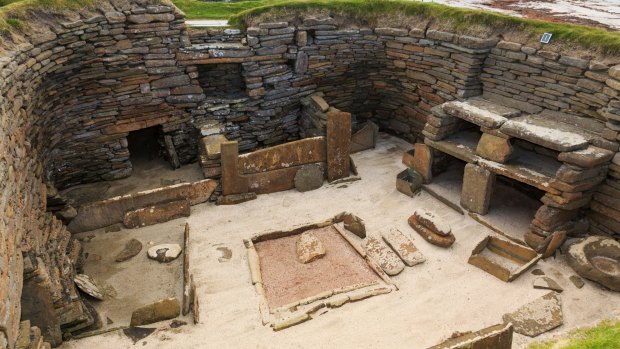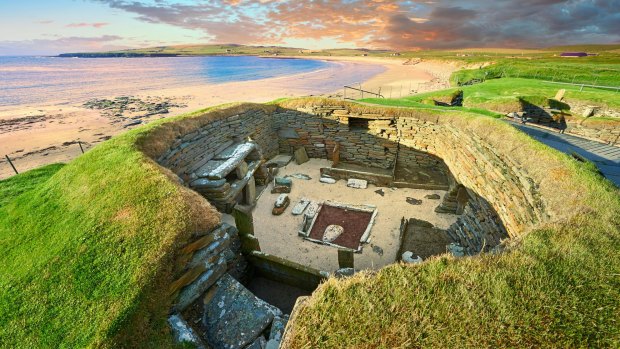By Steve Meacham

Excavations of primeval dwelling and stone furniture in the prehistoric Neolithic village.Credit: Alamy
By a picturesque beach, on one of the most windswept coasts of Scotland, there stands a series of stone-walled, grass-covered burrows that look as if they were built by the same set designers who created Hobbiton for Peter Jackson's Tolkien films.
They're so quaint you almost expect Bilbo Baggins or Gandalf to emerge at any moment.
But this really was an underground village a very long time ago, when people really did believe in dragons, ogres and elvish spirits. The men and women who lived at Skara Brae (sometimes called the "Scottish Pompeii") built their homes about 5000 years ago – making this Stone Age village centuries older than Stonehenge, the Great Wall of China or the Pyramids of Giza.

The neolithic village ruins of Skara Brae are the best of their kind in northern Europe.Credit: Alamy
Skara Brae – on the west coast of Mainland, the largest island in the Orkney archipelago – is the best-preserved Neolithic village in northern Europe: a site so significant among archaeologists that even Indiana Jones gave a lecture about it in the 2008 movie, Kingdom of the Crystal Skull.
What is arguably more remarkable than the village itself is the romantic story of how it was uncovered.
No-one knew of its existence after it was abandoned (for reasons that remain a mystery) around 2500 BC. Then in 1850 a mighty storm hit the Orkney isles, north-east of John O'Groats, removing sand dunes and exposing what appeared to be the remains of two small houses.
The local laird, William Watt, who lived at Skaill House 250 metres away (and worth a visit in its own right), explored the two houses and – not having a clue what he had discovered – began removing bits of Stone Age pottery and furniture that had been buried for millenia.
Fast forward to 1924, when Watt's trustees announced this archaeological oddity to the world by placing it under the guardianship of His Majesty's Commissioners of Works.
Enter an Australian, Professor Gordon Childe, appointed Abercromby Professor of prehistoric archaeology at Edinburgh University in 1927.
An avowed Marxist, Childe was appalled the focus of the dig at Skara Brae was commercial, exposing as much of the prehistoric village as possible to encourage potential tourists.
The irony, of course, is that Childe's painstakingly scholarly excavation has turned Skara Brae into a major tourism drawcard, with the UNESCO World Heritage-listed site drawing 73,000 visitors a year to this far-flung part of Scotland.
Most also visit Orkney's other UNESCO-listed Neolithic treasures, including The Stones of Stenness and The Ring of Brodgar – Stonehenge-like circles within 12km of Skara Brae that still mystify the experts.
But this year (2016) the Orkney Islands are celebrating a recent history. In May 1916, Britain and Germany fought the Battle of Jutland, off the coast of Denmark.
It remains the greatest naval battle in history and ended in a draw (though no doubt Germany would have won on a penalty shoot-out). And the Orkney connection?
Scapa Flow is one of the greatest natural harbours on earth, an extensive body of ocean protected on three sides by the Orkney Islands – and home to British fleets in both world wars.
Jutland was the Battle of the Battleships. Germany needed to find a way for its ships to escape the Baltic Sea. Britain needed the German fleet to be contained.
History records that when the 74 ships of the Kaiser's High Seas Fleet went to Scapa Flow to "surrender" after the Treaty of Versailles, the German commanding officer, Rear Admiral Ludwig von Reuter, ordered the entire fleet to be scuttled – turning Scapa Flow today into a mecca for cold water divers.
When we visited Kirkwall, the capital of the Orkneys in May, the locals were well poised for the centenary.
There was an illuminating exhibition at the town's eccentric museum, various excursions to Scapa Flow itself, and a weeping tear of poppies streaming from the town's magnificently Viking-themed St Magnus Cathedral.
Kirkwall. Scapa Flow. The Ring of Brodgar. The Orkneys have so much to offer, not least the incredibly green scenery.
But me? I can't go past Skara Brae.
Did you know that what makes this Neolithic settlement so rare is that the sand protected the Stone Age furniture? Or that an even earlier Stone Age settlement lies beneath Skara Brae?
TRIP NOTES
MORE INFORMATION
GETTING THERE
There are regular flights from Edinburgh, Glasgow, Aberdeen, Inverness and London. See flybe.com or ba.com.
Ferries run from Aberdeen to Kirkwall (six hours). See northlinkferries.co.uk
TRAVELLING THERE
Captain's Choice 17-day, fully inclusive Bespoke British Isles tour visits Kirkwall and the Orkney Islands cruising aboard the MS Hebridean Sky. Also visiting London, Penzance, Dublin, Douglas, the Outer Hebrides and Edinburgh, this tour departs Australia on June 4, 2017, priced from $22,270 per person twin share. For more information call 1300 176 681 or captainschoice.com.au.
Steve Meacham travelled as a guest of Captain's Choice.
Sign up for the Traveller Deals newsletter
Get exclusive travel deals delivered straight to your inbox. Sign up now.